-
|
Ross Island
|
|
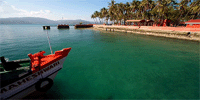
|
Once the seat of British power and capital of these Islands,
it stands now as a ruin of the bygone days with the old structure almost in debris.
A small museum named 'Smritika' holds photographs and the other antiques of the Britishers
relevant to these islands.
|
|
Viper Island
|
|
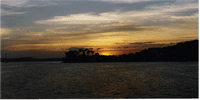
|
The Britishers used to harbour convicts here.
The first jail was constructed here which was abandoned after the construction of Cellular Jail.
It has a gallows atop a hillock, where condemned prisoners were hanged.
Sher Ali, who killed Lord Mayo, the Viceroy of India in 1872, was also hanged here.
|
|
Chatham Island
|
|

|
It has a Saw Mill lying on the tiny island connected by a bridge over a stretch of sea-water.
This Saw Mill is one of the biggest and oldest in Asia.The main mainland -Island harbour is also here.
The other harbour is Haddo, which is nearby.
|
-
|
Gandhi Park
|
|
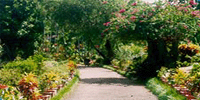
|
This beautiful park at Port Blair has facilities like amusement rides, safe water sports,
and nature trail around the lake, garden, restaurant and historic remains like Japanese Temple as well as a bunker.
The erstwhile Dilthaman tank, which was the only source of drinking water to Port Blair, and
the area around it has been developed into Gandhi Park in an unbelievably short time of 13 days.
|
|
Mini Zoo
|
|
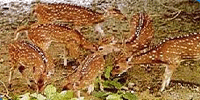
|
Situated at Haddo (Delanipur - Chatham road),
it houses some of the rare species of endemic birds and animals found in these islands.
|
|
Time: 8.00 AM - 5.00 PM Monday closed.
Entry fee – adult –Rs. 2/-, child – Re.1/-
|
-
National Memorial
|
|
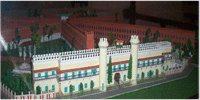
|
This three-storeyed prison, constructed by Britishers in 1906, is a pilgrimage destination for freedom fighters.
This colossal edifice has mutely witnessed the most treacherous of inhumane atrocities borne by the convicts,
who were mostly freedom fighters. Now dedicated to the nation as a National Memorial.
|
|
Anthropological Museum
|
|
|
This museum at Phoenix Bay (Bus stand – Delanipur road) depicts the life of the Paleolithic Islanders.
It also houses the models of the aborigines and their tools. Closed on Mondays and holidays.
|
(Fisheries Museum)
|
|

|
Situated near Andaman Water Sports Complex, it exhibits species of marine life peculiar to the islands and
found in the Indo-Pacific and the Bay of Bengal. Closed on Mondays and holidays.
|
|
Entry fee – adult –Rs. 2/-, child(upto 12 years) – Re.1/-
Video without focus light – Rs. 25/-
|
(Naval Marine Museum)
|
|

|
Situated opposite to Andaman Teal House, Delanipur this museum is meant to create awareness on various aspects of oceanic environment.
A good collection of shells, corals and a few species of colourful fishes found in these islands are on display.
|
|
Time: 8.30 AM – 12.00 Noon, 2.00 PM – 5.00 PM, Monday & holiday closed.
Entry fee - Rs. 10/-
|
|
Zoological Survey of India Museum
|
|
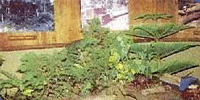
|
Situated near to Andaman Teal House, this museum and research library exhibit a good variety of sponges,
corals, butterflies, centipedes etc., Open on all working days.
|
|
Forest Museum
|
|
|
Situated at Haddo (near to the Zoo), this museum offers an insight into forest activities through scale models and
displays decorative pieces made of famous woods like Padauk, Marble, Peauma, Gurjan, Satin Wood, etc., Open on all working days.
|
-
|
Here is the place where you come to know that Andaman & Nicobar islands were all part of the South Asian mainland with continuous mountain range running down from the Arakan Yomas in Burma through Sumatra, Java and Indonesia.
Then, 150 million years ago, due to geological activity, the land submerged and created the islands of mountaintops. The genesis of the Andaman & Nicobar archipelago is depicted through interactive exhibits in the Andaman & Nicobar islands gallery of the centre.
But it is only a part of the whole. This science centre explains the science of oceans, while allowing the visitors to create waves of varying parameters and explore their features. Here you can see the youngest rock sample found in India.
It is a testimony to the under-crust activities still going on around the Barren Island. Finish with it and you are invited to the flora and fauna of the islands, to its tourist attractions or to the rare simulated view of the oceanic floor.
Once you feel confident to face a quiz on the A & N islands, enter the quiz corner. But it is one with a difference. A computer plays the quizmaster; it automatically throws questions at you and evaluates your answers.
Please call your friends and family to enjoy the quiz. It allows six groups of two persons each to participate and compete with each other.
Hands-on-easy to use exhibits in the Fun Science gallery tempt one to play with them and explore the ‘how’ and ‘why’ of common scientific phenomena. Roll a ball, press a switch, rotate a crank, and amusing things happen, albeit, scientifically.
In this hall, you can play with mirrors, paint pictures with free falling liquids or enjoy illusions. here rolling balls perform acrobatics, vortex is formed in water and complex rules of probability turns to be an exciting game of fun.
The Modern Technology gallery introduces the frontier fields of ‘Biotechnology’, fathoms the ‘Space’ and elucidates ‘Nuclear Technology’. Several computer kiosks provide engrossing multimedia experience on these key areas.
Taramandal, the portable planetarium of this centre, simulates the night sky of Port Blair or any other place in the northern hemisphere. One learns to identify stars and constellations so very easily here. The real sky no longer remains an enigma thereafter.
This portable planetarium is the only one of its kinds in the a & N islands.
Out there, in the open air, is the lush green science park where parabolic reflectors send whispers to a distant destination, hollow pipes can be made to generate music, and models of prehistoric animals take one through the course of evolution of life on earth.
To match with this natural set up, the centre houses the only in-house Butterfly corner of the islands. All the butterflies seen here are bred and reared in the corner itself.
|
|
How To reach?
|
|
HOW TO REACH:
|
|
Goodwill Estate
Corbyn’s Cove Road
Port Blair
Phone : 229034
Opening Hours : 10 AM to 5.30 PM (except Wednesday)
|
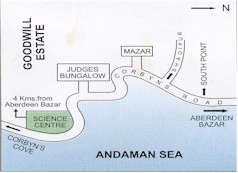
|
|
|
Entry Fee:
|
|
| Adults |
Rs.5/- |
| Children (below 14yrs) |
Rs.2/- |
|
|
Fee for Science Shows:
|
|
| 'Unexpected Science' Show |
Rs.2/- |
| 'Fun-tastic' Chemistry Show |
Rs.2/- |
| Planetarium Show |
Rs.2/- |
| Sky Observation & Film Show |
Rs.2/- |
|
|
Photography Fee:
|
|
| Inside the Science Centre |
Rs.10/- |
|
| Back To Description |
-
|
|
|
|
|
|
Cellular Jail, located at Port Blair, stood mute witness to the tortures meted out to the freedom fighters, who were incarcerated in this Jail.
The Jail, completed in the year 1906 acquired the name, ‘cellular’ because it is entirely made up of individual cells for the solitary confinement of the prisoners.
It originally was a seven pronged, puce-coloured building with central tower acting as its fulcrum and a massive structure comprising honeycomb like corridors.
The building was subsequently damaged and presently three out of the seven prongs are intact. The Jail, now a place of pilgrimage for all freedom loving people, has been declared a National Memorial.
The penal settlement established in Andamans by the British after the First War of Independence in 1857 was the beginning of the agonising story of freedom fighters
in the massive and awful jails at Viper Island followed by the Cellular Jail. The patriots who raised their voice against the British Raj were sent to this Jail, where many perished.
Netaji Subash Chandra Bose hoisted the tri-colour flag to proclaim Independence on 30th December 1943 at a place near this Jail.
This three-storeyed prison, constructed by Britishers in 1906, is a pilgrimage destination for freedom fighters. This colossal edifice has mutely witnessed the most treacherous of
inhumane atrocities borne by the convicts, who were mostly freedom fighters. Now dedicated to the nation as a National Memorial.
The saga of the heroic freedom struggle is brought alive in a moving Son-et-Lumiere, shown daily inside the jail compound at 6.00 PM (Hindi) and 7.15 PM (English). Also there is a Museum,
an Art gallery, and a Photo gallery, which are open on all days except Monday from 9.00 AM to 12 Noon and 2.00 PM to 5.00 PM.
|
|
-
|
|
Ross Island, the erstwhile capital of Port Blair during the British regime, is a tiny island standing as guard to Port Blair harbour.
The island presently houses the ruins of old buildings like Ballroom, Chief Commissioner’s House, Govt. House, Church, Hospital, Bakery, Press,
Swimming Pool and Troop Barracks, all in dilapidated condition, reminiscent of the old British regime.
Ever since Dr. James Pattison Walker arrived in Port Blair aboard the East India Company’s steam frigate ‘Senuramis’ on 10th March 1858,
this island remained under British occupation till 1942. From 1942 to 1945, the island was under the occupation of Japanese. However,
the allies reoccupied the island in 1945 and later abandoned it.
During British occupation, this island was the seat of power of the Britishers. It was developed into self-equipped township with
all facilities required for a civilized colony. Dr. Walker, Chairman of the Andaman Committee, established the infamous and
the dreaded Penal Settlement with 200 convicts. The Britishers even persuaded the aborigines to come and live in some huts
at Ross Island and even established an Andaman Home for them in 1863. Later on the services of these Andamanese were used to catch the escaping convicts from Ross Island.
The island with historical background and preservable ruins is spread along an area of 0.6 sq. kms. With the ruins and also with the historical background,
the Island has gained a lot of popularity among the tourists.
Ross island is open for the tourists to visit during day time as the boat services are available from the Phoenix Bay jetty at 8.30 AM, 10.30 AM, and 12.30 PM. Navy has established a museum on the Island Known as ‘Smritika’ depicting the history of the Island.
|
-
|
|
The tiny, serene, beautiful island of Viper witnessed the untold sufferings the freedom fighters had to undergo. Dangerous convicts found guilty of
violating the rules of the Penal Settlement, were put in fetters and were forced to work with their fetters on in this island. Freedom fighters
like Nanigopal and Nandlal Pulindas, who had resorted to hunger strike at the Cellular Jail, were imprisoned at Viper Island. The jail at Viper,
where prisoners deported from the mainland were confined, was built by the British under the supervision of Major Fort. Work on the prison was
started in 1867. Owing to the working conditions, the jail earned the notorious name Viper Chain Gang Jail.
The island derives its name from the vessel ‘Viper’ in which Lt. Archibald Blair came to the islands in 1768 with the purpose of establishing a Penal Settlement.
The vessel, it is believed, met with an accident and its wreckage was abandoned near the island.
Gallows built on top of a hillock, visible to all prisoners in the island, signified death. Sher Ali, the Pathan, guilty of murdering Lord Mayo, was condemned to death and hanged at Viper Island.
The Harbour cruise, available daily from Phoenix Bay Jetty (at 3 PM), provides a panoramic view of different points around the harbour and includes a trip to Viper Island.
|
|